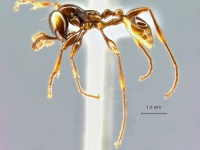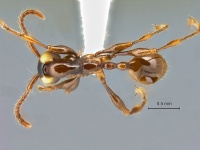Aenictus pfeifferi
| Aenictus pfeifferi | |
|---|---|

| |
| Scientific classification | |
| Kingdom: | Animalia |
| Phylum: | Arthropoda |
| Class: | Insecta |
| Order: | Hymenoptera |
| Family: | Formicidae |
| Subfamily: | Dorylinae |
| Genus: | Aenictus |
| Species: | A. pfeifferi |
| Binomial name | |
| Aenictus pfeifferi Zettel & Sorger, 2010 | |
Inhabits primary rainforests from 40 to 700 m elevation.
Identification
Jaitrong and Yamane (2011) - A member of the currax group. This species is very similar to Aenictus currax, Aenictus diclops, Aenictus huonicus, Aenictus parahuonicus and Aenictus wayani. However, it is easily separated from them by the head having only 2 standing hairs on the vertex (in the others the head with some shorter standing hairs in addition to two long hairs on vertex) and long pronotal hairs shortest (0.23–0.25 mm) among the members of this group (except in A. glabrinotum that has no hairs on promesonotum) (see A. huonicus).
Zettel & Sorger (2010) - Head with distinct “Typhlatta spots.” Occiput on each side with small elevation. Parafrontal ridge present, very short. Clypeal teeth absent, margin nearly straight. Mandible broad, with subapical tooth and ca. 7 minute denticles. Antenna 10-segmented. Pronotal humeri unarmed. Propodeum low, rounded. Subpetiolar process low. Tarsi wide, tarsomere 5 strongly bilobed at dorsoapical margin.
Aenictus pfeifferi is closely related to Aenictus gracilis and reaches, together with this species, couplet 20 in the key by Wilson (1964). This is a widely distributed species, from Sri Lanka to the Philippines, which – according to Wilson (1964) – expresses some intraspecific variation, especially in HW, SI, and size of occipital protuberances. For comparison, we studied a syntype of A. gracilis from Sarawak, a syntype of Aenictus martini from Myanmar (both specimens in the Natural History Museum Vienna), and non-type specimens from Sri Lanka, Borneo, and the Philippines. Aenictus pfeifferi differs clearly from A. gracilis by larger head width (HW 0.78 - 0.87 mm in A. pfeifferi vs. 0.50 - 0.64 mm in A. gracilis; fide Wilson 1964), differently sculptured propodeum (smooth in A. pfeifferi vs. totally reticulate or at most medially with narrow stripe of reduced sculpture in A. gracilis) and strongly different tarsal structures. All tarsi of A. pfeifferi are strongly enlarged. On the foretarsus, tarsomeres 3 and 4 are wider then long in A. pfeifferi but slightly longer than wide in A. gracilis; and tarsomere 5 is hardly (abouth one fourth) longer than wide in A. pfeifferi but ca. 1.5 times longer than wide in A. gracilis. The apical width of tarsomere 5 of the hind tarsus is much wider than in A. gracilis (0.14-0.15 mm vs. 0.08-0.10 mm). The dorsoapical margin of tarsomere 5 is strongly bilobed in both species. Tarsal structures vary strongly among species of Aenictus and – although ignored in the past – they may serve as useful characteristics for species distinction.
Keys including this Species
Distribution
Known from Borneo (Sabah and Sarawak).
Latitudinal Distribution Pattern
Latitudinal Range: 4.95° to 4.95°.
| North Temperate |
North Subtropical |
Tropical | South Subtropical |
South Temperate |
- Source: AntMaps
Distribution based on Regional Taxon Lists
Indo-Australian Region: Borneo (type locality), Indonesia, Malaysia.
Distribution based on AntMaps
Distribution based on AntWeb specimens
Check data from AntWeb
Countries Occupied
| Number of countries occupied by this species based on AntWiki Regional Taxon Lists. In general, fewer countries occupied indicates a narrower range, while more countries indicates a more widespread species. |

|
Estimated Abundance
| Relative abundance based on number of AntMaps records per species (this species within the purple bar). Fewer records (to the left) indicates a less abundant/encountered species while more records (to the right) indicates more abundant/encountered species. |

|
Biology
The type locality lies in the Gunung Mulu National Park in Sarawak, Borneo. The new species was collected in an alluvial forest along a concrete trail along Melinau river from Park Headquarters to Moonmilk cave at an elevation of ca. 40-50 m a.s.l. (4°2’30” N, 114°48’46” E; google maps estimate).
Castes
Known only from the worker caste.

| |
| . | |
Nomenclature
The following information is derived from Barry Bolton's Online Catalogue of the Ants of the World.
- pfeifferi. Aenictus pfeifferi Zettel & Sorger, 2010b: 116, figs. 1-4, 13 (w.) BORNEO (East Malaysia: Sarawak).
- Type-material: holotype worker, 74 paratype workers.
- Type-locality: holotype Malaysia: Borneo, Sarawak, Gunung Mulu Nat. Park, Moonmilk Trail, 4°2’30’’N, 114°48’46’’E, 13.xi.2009, no. 81 (D.M. Sorger); paratypes with same data.
- Type-depositories: NHMW (holotype); ABNC, DMSC, FRCK, HSZC, NHMW, SKYC, TNHM (paratypes).
- Status as species: Jaitrong & Yamane, 2011: 21 (redescription); Pfeiffer, et al. 2011: 32.
- Distribution: Malaysia (Sarawak).
Unless otherwise noted the text for the remainder of this section is reported from the publication that includes the original description.
In the Natural History Museum Vienna we have seen specimens from the Khao Sok National Park in southern Thailand which are extremely similar to types of A. pfeifferi, except for a slightly more developed sculpture on mesopleuron and anterior metapleuron. Although we are inclined to regard this difference as an intraspecific variation, we do not include this series in the type material of A. pfeifferi.
Description
Worker
Holotype: BL 4.35 mm; HW 0.85 mm; HL 1.00 mm; CI 85; SL 0.81 mm; SI 95; ML 1.52 mm; PHL 0.40 mm.
Paratypes (n = 10): BL 3.75-4.50 mm; HW 0.78-0.87 mm; HL 0.91-1.02 mm; CI 83-88; SL 0.67-0.81 mm; SI 86-95; ML 1.39-1.57 mm; PHL 0.33-0.42 mm.
Head blackish brown with large and distinct “Typhlatta spots.”
Mesosoma, petiole, postpetiole and gaster medium to dark brown dorsum of mesosoma, node of petiole, and gaster tergites strongly infuscated; venter of abdomen usually pale brown, first sternite often infuscated. Antenna medium brown, scape often infuscated. Legs medium brown, in middle part of femora, middle and hind tibia near base, and tarsomeres 1-2 on middle and hind legs variably infuscated.
Pilosity: Setae scattered and of very different lengths. Longest setae on scape (several), on occiput (one pair) and on pronotum (one pair); setae of medium length on sides (only two pairs) and venter of head, on mesosoma, petiole, postpetiole, and gaster. Dorsum and sides of mesosoma with some short, almost appressed setae intermixed.
Structural characteristics: Head completely smooth. In full face view occipital margin slightly biconcave, two small elongate impressions separating weakly developed occipital tubercles. Parafrontal ridge weakly developed as a low, elongate tubercle lateral of antennal insertion. Mandibles punctate (with hair pits). Antennae long, flagellum relatively slender. Mesosoma with dorsal outline similar to A. gracilis, gently biconvex, at propodeum evenly downcurved. Sculpture on mesosoma strongly reduced; dorsum and sides almost smooth. Most anterior part of pronotum delicately reticulate. Mesopleuron strongly reticulate and strongly contrasting with other parts of mesosoma; on its dorsal part some indistinct wrinkles. Similar, weakly developed wrinkles below propodeal stigma. Petiole elongate, subpetiolar process very low, forming a sharp angle at its anterior edge. Postpetiole of similar shape as petiole, its anteroventral edge sharp. Both petiole and postpetiole with delicate granulation laterally and ventrally, dorsum smooth. Gaster smooth except for hair pits; most anterior part of tergite 1 reticulate.
Jaitrong and Yamane (2011) - Measurements (n = 10 including the four paratypes): TL 4.35–5.20 mm; HL 0.93–1.13 mm; HW 0.80–1.03 mm; SL 0.60–0.88 mm; ML 1.35–1.75 mm; PL 0.33–0.38 mm; CI 86–93; SI 75–85.
Redescription of worker (Paratype and non-types). Head in full-face view slightly longer than broad, with sides slightly convex and posterior margin almost straight or feebly concave; occipital carina complete, not interrupted medially. Antennal scape extending only 2/3 of head length; antennal segments II–X each longer than broad; II almost as long as each of III–VI. Frontal carina very short, not extending beyond the level of posterior margin of torulus. Parafrontal ridge almost absent. Masticatory margin of mandible with a large apical tooth followed by a medium-sized subapical tooth and 5–6 denticles; basal margin with a series of ill-defined denticles. Mesosoma relatively elongate and stout; promesonotum in profile convex dorsally and sloping gradually to metanotal groove; mesopleuron clearly demarcated from metapleuron by a groove. Propodeum in profile with weakly convex dorsal outline; propodeal junction rounded; declivity of propodeum shallowly concave, and encircled with a thin rim; area below propodeal spiracle distinctly impressed; opening of propodeal spiracle clearly circular with its diameter about 2.4–2.5 times as long as diameter of postpetiolar spiracle. Petiole slightly longer than high, with its dorsal outline convex; subpetiolar process weakly developed and triangular, with its ventral outline feebly convex, and anteroventral corner roundly angulate or produced. Postpetiole almost as long as petiole, with its dorsal outline convex.
Head entirely smooth and shiny; mandible finely striate in basal 1/2 to 2/3, and smooth in apical and peripheral parts; antennal scape dorsally smooth but ventrally sculptured. Pronotum smooth and shiny except for the anteriormost portion punctate; mesonotum smooth and shiny; mesopleuron macroreticulate, bearing several longitudinal rugae; metapleuron superficially sculptured and shiny. Propodeum dorsally entirely smooth and shiny; lateral face of propodeum wrinkled but shiny. Petiole and postpetiole entirely smooth and shiny. Legs smooth and shiny.
Vertex with a pair of long standing hairs; mesosoma dorsally with relatively sparse standing hairs mixed with sparse short decumbent hairs; longest pronotal hair 0.23–0.25 mm long. Hairs on legs generally short and appressed to surface; mid- and hind tibiae without outstanding long hairs on outer face; hairs on fore femur also short and decumbent. Entire body light brown to brown, with a rather large typhlatta spot on the occipital corner.
Type Material
Holotype worker (in Natural History Museum Vienna, Austria) and 74 paratype workers (in Natural History Museum Vienna, Austria; AntBaseNet Collection, Ulm, Germany; Sarawak Forest Department Collection, Kuching, Borneo; coll. D. M. Sorger, Vienna, Austria; coll. H. & S. V. Zettel, Vienna, Austria) from Borneo, Sarawak, Gunung Mulu National Park, Moonmilk Trail, 4°2’30” N, 114°48’46” E, 13.XI.2009, leg. D. M. Sorger (81)
Jaitrong and Yamane (2011) - The holotype and 74 paratype workers (Naturhistorisches Museum Wien, Vienna) from Borneo, Sarawak, Gunung Mulu N.P. (four paratypes were examined, SKY Collection and Natural History Museum of the National Science Museum).
Etymology
We dedicate this species to Dr. Martin Pfeiffer, who contributed much effort in ecological and taxonomic investigations on the ants of Borneo and who enabled the junior author’s participation in an expedition to Sarawak in 2009.
References
- Jaitrong, W. & Yamane, S. 2011. Synopsis of Aenictus species groups and revision of the A. currax and A. laeviceps groups in the eastern Oriental, Indo-Australian, and Australasian regions (Hymenoptera: Formicidae: Aenictinae). Zootaxa, 3128, 1–46. PDF
- Yamane, S., Tanaka, H.O., Hasimoto, Y., Ohashi, M., Meleng, P., Itioka, T. 2021. A list of ants from Lambir Hills National Park and its vicinity, with their biological information: Part II. Subfamilies Leptanillinae, Proceratiinae, Amblyoponinae, Ponerinae, Dorylinae, Dolichoderinae, Ectatomminae and Formicinae. Contributions from the Biological Laboratory, Kyoto University 31, 87–157.
- Zettel, H. and Sorger, D.M. 2010. Three new species of the army ant genus Aenictus Shuckkard, 1840 (Hymenoptera: Formicidae:Aenictinae) from Borneo and the Philippines. Z.Arb.Gem.Öst.Ent.(62)115-125.
References based on Global Ant Biodiversity Informatics
- Borowiec M. L. 2016. Generic revision of the ant subfamily Dorylinae (Hymenoptera, Formicidae). ZooKeys 608: 1–280.
- Jaitrong W.; Yamane, S. 2011. Synopsis of Aenictus species groups and revision of the A. currax and A. laeviceps groups in the eastern Oriental, Indo-Australian, and Australasian regions (Hymenoptera: Formicidae: Aenictinae). Zootaxa 3128:1-46.
- Pfeiffer M., D. Mezger, and J. Dyckmans. 2013. Trophic ecology of tropical leaf litter ants (Hymenoptera: Formicidae) - a stable isotope study in four types of Bornean rain forest. Myrmecological News 19: 31-41.
- Pfeiffer M.; Mezger, D.; Hosoishi, S.; Bakhtiar, E. Y.; Kohout, R. J. 2011. The Formicidae of Borneo (Insecta: Hymenoptera): a preliminary species list. Asian Myrmecology 4:9-58
- Zettel H., and Sorger, D. M. 2010. Three new species of the army ant genus Aenictus Shuckard, 1840 (Hymenoptera: Formicidae: Aenictinae) from Borneo and the Philippines. Zeitschrift der Arbeitsgemeinschaft Österreichischer Entomologen 62:115-125.

